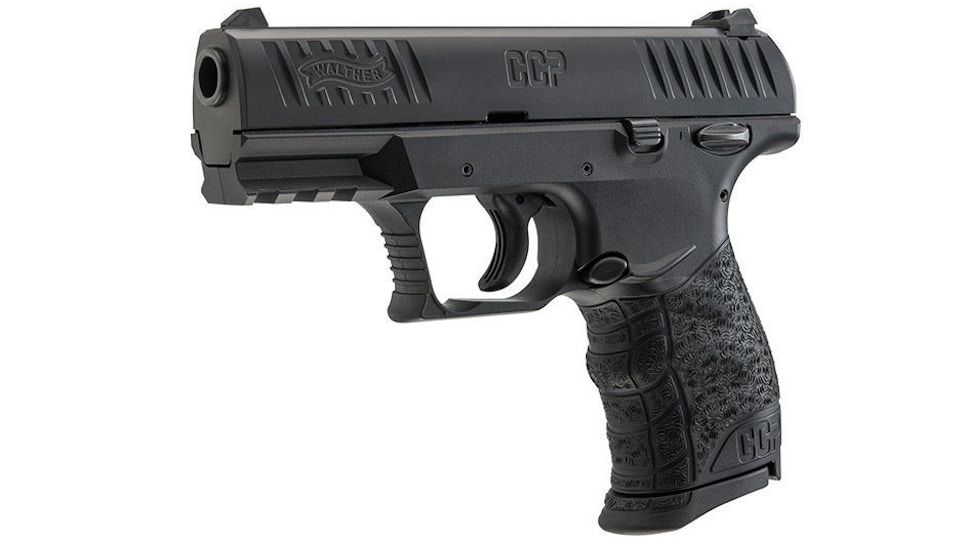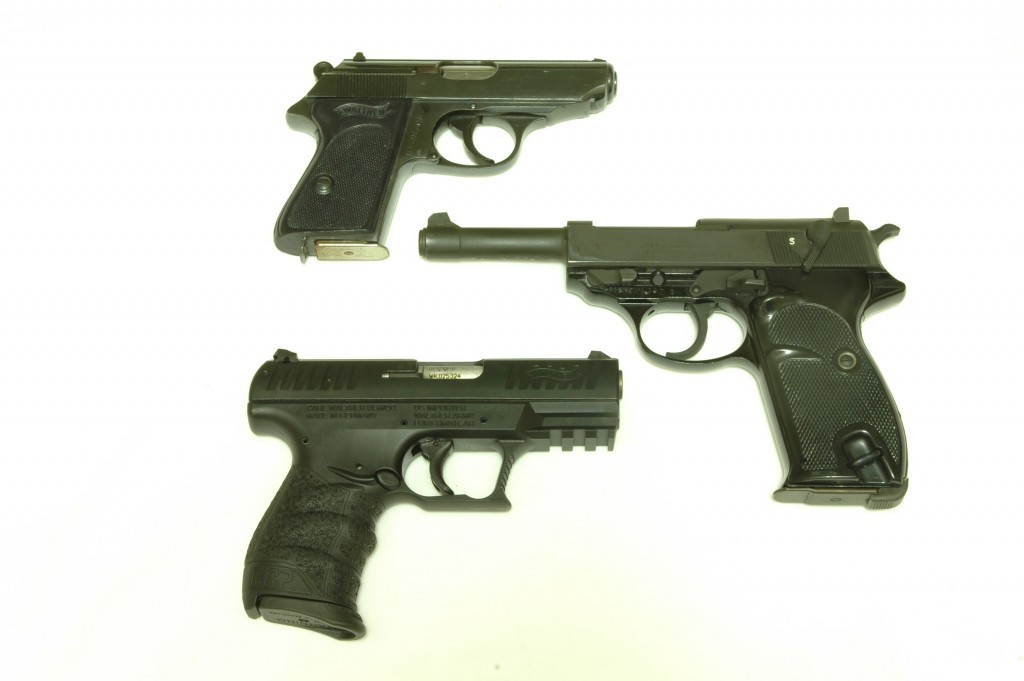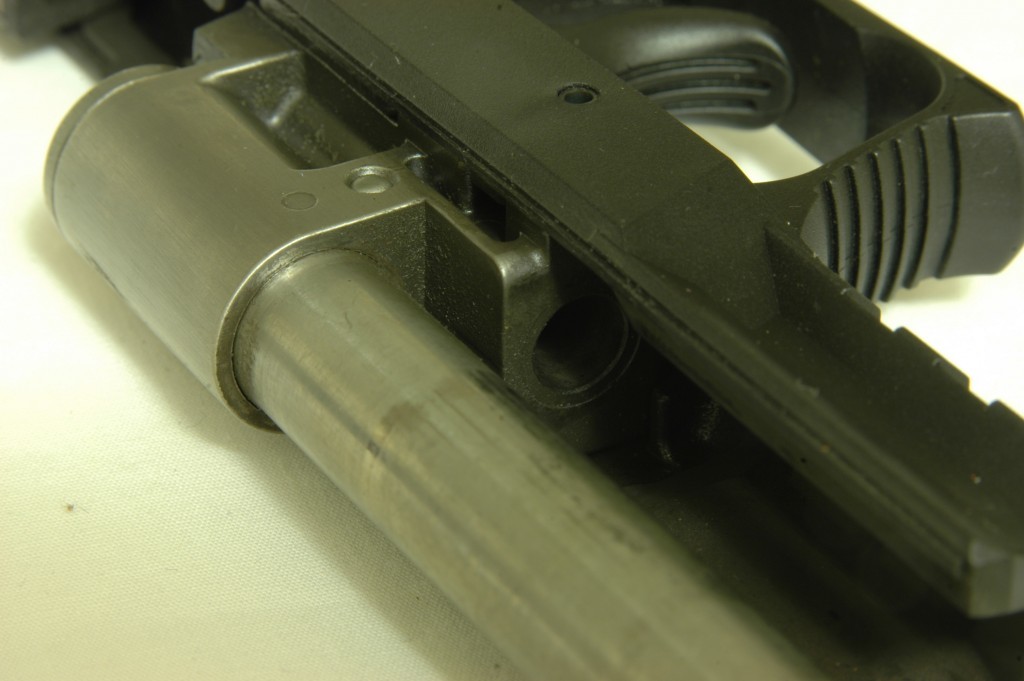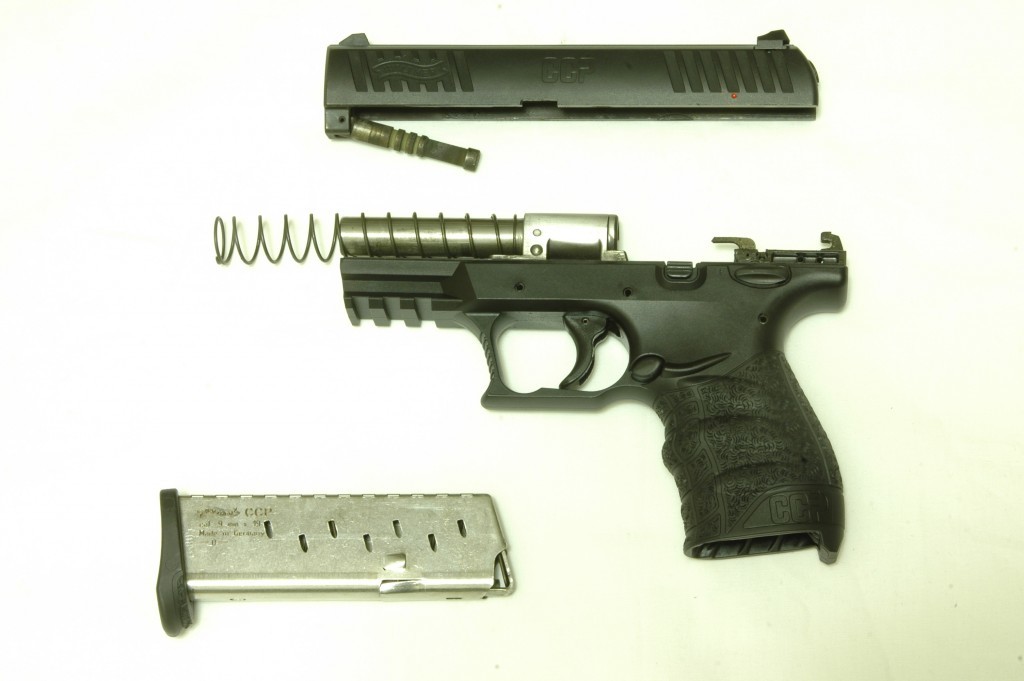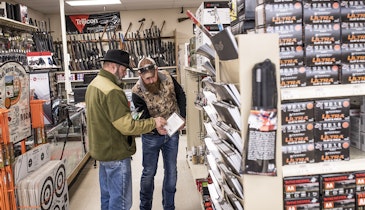By Jeremy D. Clough
There are ideas in the firearms world that surface every decade or so. They submerge and then reappear — not because the idea itself is invalid, but because people often can’t make it work.
Near the top of the list is the use of the gas-delayed blowback system in handguns.
Seldom seen in modern pistols, we were surprised to find one at last year’s SHOT Show when we had the chance to shoot Walther’s CCP. A sleek, single-stack 9mm from the legendary German gunmaker, the accurate, easy-shooting auto is equipped with a gas system Walther calls the “softcoil.”
Before we talk too much about the CCP itself, we should start with a brief tour of Walther’s history to put it in context.
Carl Walther Waffenfabrik had been in business for more than 40 years and made semi-auto pistols — at least one of which had been adopted for military use — for at least half that time, prior to its introduction of the PP in 1929. It is the PP, however, and its truncated offspring — the PPK — that were the first truly innovative pistols produced by the German company.
The slim .32-caliber Polizeipistole offered a double-action mechanism with a decocking safety as well as a spring-operated, loaded chamber indicator combined in a flat, sleek package that was easy to carry. While it was not the first double-action semi-auto (that honor goes to the “Little Tom” produced a decade before in Austria and Czechoslovakia), the PP is the one with the first real commercial success.
The .32-caliber Polizeipistole was followed up in 1930 by the PPK (Polizeipistole Kriminal), which boasted a barrel and grip frame shortened for concealment. To say the PP and PPK pistols were well-received would be an understatement. Offered in .380 ACP, .32 ACP, the ultra-rare .25 ACP model and .22 LR, the PPK became one of the most influential pocket pistols of all time, whose lines are clearly seen in the Astra Constable, Mauser HsC, SIG Sauer P230/232 and the Com-bloc Makarov.
The features introduced in the PP also continued to be developed within Walther, leading to the release in 1938 of its P38 9mm, which replaced the P08 Luger to become the issue pistol for German soldiers during WWII. Afterwards, in alloy-framed P1 guise, it armed the newly forming West German Bundeswehr.
A single-stack, eight-shot 9mm with an open-top slide in addition to the double-action trigger and loaded-chamber indicator of the PP and PPK, the P38 used a unique barrel-locking wedge that meant the barrel moved forward and aft instead of the more common Browning tiling barrel design adopted by the vast majority of semi-auto handguns.
While this might seem little more than a mechanical footnote, the fact that the barrel didn’t tilt makes the P38 and its progeny an excellent host for a suppressor since the mechanism doesn’t have to overcome the cantilever effect created by the weight of the suppressor in order to function. This locking system lives on in the high-end Korth semi-auto pistols and in the Beretta 92F, which, in its major-mechanical features, is a re-skinned P38 with a high-capacity magazine — a feature popularized by the Browning Hi-Power P35, also used in WWII by the Germans.
For those unfamiliar with the “gas gun” idea as applied to a handgun, pistols chambered for 9mm and up need a way to keep the slide from moving backwards immediately after the gun fires so that chamber pressure can drop to a safe level before the breech opens. Those with no mechanical means to slow the slide travel are called “blowbacks,” and that’s an acceptable system for calibers such as the .380 ACP, .32 ACP and other small, less-powerful cartridges.
Most defensive pistols, however, have a locked breech that uses a pivoting or rotating barrel locked to the slide at the moment of ignition and recoils with the slide for the first part of the slide’s rearward travel, so that the mass of the barrel is added to that of the slide, creating more resistance that the recoil impulse of the gun must overcome before the breech finally opens. This slows the slide down so when the breech finally does open, the chamber pressure has dropped to a safe level.
The difference between traditional locked breech guns and the CCP (and the HK P7 before it) is that the CCP has no locking system, but instead uses a gas port drilled into the bottom of the fixed, non-moving barrel just forward of the barrel. The port directs the gas forward into a cylinder in the frame that is beneath and parallel to the barrel. The cylinder is blocked at the front by a piston attached to the slide and the gas vented from just forward of the chamber pushes against that piston, slowing the slide’s rearward movement.
Hence, the name “gas-retarded blowback;” since the breech is not mechanically locked together to the slide it is a blowback system, but the use of high-pressure gas vented from the chamber retards slide movement.
The problem with the gas-delayed blowback has been that the pistols often did not work. Due in large part to the dirty nature of routing the post-combustion gas — burned powder and all — into the gun, pistols such as the South African Vektor 9mm have been introduced to great fanfare, only to fail and become a footnote to why locked-breech systems still rule the day. To date, the HK P7 is the only gas-delayed handgun to meet with long-lasting success.
Against what must now seem like a pessimistic backdrop, we return to the CCP.
Introduced in 2014, the CCP follows the design language introduced by the polymer-framed P99 and its understudy, the P22, rather than the classic lines of the PP/PPK series. Sights appear to be polymer, with inset white dots. The rear, wedge-shaped sight is mounted in a dovetail, while the .15-inch-wide front sight appears to be attached to the slide by its stem and is marked with a “1.” Other height sights (it comes with two) are available to adjust for elevation.
Both the front and rear of the slide have broad, shallow cocking serrations with the front serrations interrupted to show the Walther banner logo. The slide itself, when viewed from the rear, has a mild triangular cross-section, with the convex sides of the slide curving up to meet a low, flat rib on top of the slide. The resultant effect gives the gun a much more subtle profile for concealed carry than the square lines of, say, a Glock or Kahr, which can make it harder to break up the outline of the gun.
The black polymer frame has a molded-in light rail, a feature which has become de rigeur on modern autopistols, but is likely of limited utility on this one. The slidestop is a small, bent, metal tab protected by a molded-in fence, and a slim, oval thumb safety on the left side of the gun pivots at the rear in M1911 style — up for “safe,” and down for “fire.”
Other controls consist of the trigger, with three wide serrations in its face, and the smooth magazine release, also protected like the slide stop, with a low ridge. One of the advantages of using polymer as a grip material is the ability to mold irregular shapes, and the CCP’s grip has a deep, high undercut beneath the trigger guard to let the pistol sit low in the hand, reducing felt recoil.
A pair of mild finger swells on the front strap, coupled with raised, oval sections on each side of the grip, locate the gun comfortably in the hand, and fine curved hash marks add a bit of purchase without being abrasive. The downside of a single-stack is less ammo, but the upside is a slim-grip frame. Front-to-rear, the CCP measures around 2 inches at the widest point, making the grip a good fit for those with small hands for whom a double-stack might prove much harder to hang on to.
Weight is an easy-to-manage 22.5 ounces, placing the CCP a bit heavier than the Glock 43 and Ruger LC9. While our first test gun had some inconsistency in the trigger, the second gun was much better. It broke at an expected average of 5 pounds, 11 ounces.
One of the gun’s unusual features is the disassembly. Not unlike the PPK, the forward part of the slide is more or less supported by the barrel, while the rear seems to be largely located by the frame-mounted hook that rides in the slot of the slide’s striker channel. A plunger at the rear of the striker spring must be depressed in order to draw the slide back and lift it up off the frame. While we managed to use a small screwdriver as a field-expedient way of stripping the gun, there is a tool included with the CCP, and that’s the preferable option.
Reassembly can also be a bit complex, as it is possible to partially seat the slide on the frame in such a way that the frame-mounted hook becomes trapped in the coils of the striker spring.
We had two test guns for this article. While the first made it through roughly 500 rounds admirably, it developed an issue with the takedown arrangement and had to be returned. While the final reason for this failure is still unclear, the preliminary report was that the malfunction was caused by a spring issue.
In testing the CCP, we followed our usual protocol of firing 500 rounds of mixed ball and hollowpoint ammo without cleaning or oiling, and followed it up with a few extra mags for a total of 560 rounds fired. Test ammo was provided by SIG Sauer, which supplied its V-Crown JHP in 115-, 124- and 147-grain variant, and Black Hills, which sent a case of mixed ball and hollowpoint — including a 124-grain JHP and 115 JHP in both standard and +P variants. We also threw in some White Box Winchester 115-grain ball for good measure.
The CCP passed reliability testing with flying colors, and its only bobbles were when a round did not fully chamber at 550 rounds (the slide seated fully on its own when we removed the magazine and slapped it back into place), and a second induced by a shooter error when we accidentally activated the thumb safety during a string of fire.
While the gas system is a dirty one compared to the usual locked-breech design, where combustion gases are intended to exit the barrel at the muzzle, this in no way affected the gun’s reliability. As mentioned above, we never cleaned the test gun and it easily passed 500 rounds without issue.
Accuracy was more than adequate for the intended use. Although the fixed-barrel design is inherently accurate, the human factors involved in shooting a pistol with a short sight radius often makes it difficult for shooters to wring that performance out of the gun. While it did require focused concentration to shoot groups with the CCP, we were able to post handheld groups at 25 yards as small as 4 inches while shooting standing from a modified Weaver. Recoil has a bit of a snap compared to what you’d expect from a locked-breech 9mm, but it was not unpleasant even with +P loads, and we had no problem doing fast work with the CCP.
One of the unavoidable results of routing burned gasses back into the pistol is that the gun tends to warm up pretty fast. In a box of ammo, you might notice it, but it won’t be unpleasant. However, when we did the volume shooting part of the test, we quickly heated the gun to the point that it was literally too hot to hold. This isn’t limited to the CCP — the HK P7 was known for its heat and the M8 model even came with a heat shelf attached to the front of the trigger guard to keep the shooter’s fingers from being burned.
While this might be a deterrent in a service pistol, for a concealed carry gun likely to be carried more than shot, and not typically shot in long, high-volume strings of fire, it’s not a substantial drawback. The heat also didn’t affect the gun’s function. While we had one incident of the slide becoming a little sticky when cycled manually when the gun was hot, it never failed to feed or fire.
In a world where innovation is often in short supply, the CCP is a pistol whose mechanical accomplishment is applying a system that has been problematic for others, but not for Walther. For those less interested in the “why” of the gun than the “how well,” the CCP functioned reliability at every turn, with every load we put in it and shot groups far more impressive than we expected. For those interested in a single-stack 9mm carry pistol, the CCP is a superb choice.
Walther CCP Specs:
Operation: Gas delayed blowback
Caliber: 9mm
Finish Color: Cerakote black, stainless steel
Barrel Length: 3.54 inches
Trigger Pull: SA, 5.5 pounds
Trigger Travel: 0.27 inches
Capacity: Eight rounds
Overall Length: 6.41 inches
Height: 5.12 inches
Width: 1.18 inches
Weight (mag empty): 22.33 ounces
